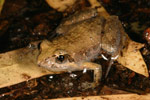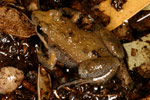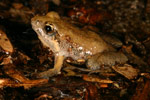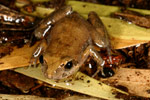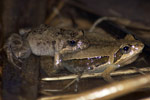Crinia parinsignifera
Eastern Sign-bearing Froglet
Also: Beeping Froglet, Plains Froglet

+ 48 kb Eastern Sign-bearing Froglet (Crinia parinsignifera)
A small ground dwelling frog, the Plains Froglet is quite conspicuous by its habit of calling year round, often during the day.
Distribution and habitat

Adults are most common in woodlands, floodplains, and open and disturbed areas. Within these habitats they shelter under logs and other debris, usually in moist depressions or near water. It is not uncommon to find dozens of individuals under one log or rock. Eggs and tadpoles are aquatic and can be found in ponds, dams, swamps, flooded grassland, ditches and hollows.
There is a detailed distribution map available for: Victoria.
Calling
Males call from among vegetation at the waters edge or from emergent vegetation. The call is a long harsh squelching note - "eeeeeeeeek" - repeated every few seconds.
Copyright Murray Littlejohn. Recorded by Murray Littlejohn. Must not be reproduced without permission.
Life cycle
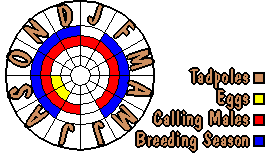
Distinguishing characteristics
Adult
length: 18-24mm.
Eggs are pigmented and found individually or in loose clumps, scattered around the bottom of ponds. Tadpoles are light grey or brown all over with scattered dark flecks. Adults have a granular belly which is light grey, or muddy white, peppered with darker flecks. The patterning on the back is variable but three patterns (morphs) are recognised: [1] ridged (longitudinal ridges along back); [2] lyrate (boomerang shaped ridges over the shoulder and on the back); and [3] smooth (back smooth, unpatterned, or with small warts).
Visible features
Presented here is the information stored in the frogs.org.au database which is used to identify frogs based on their appearance. It is intended to be used in a key guide for separating species so some of the information (for example, back colours) may be rather non-specific. The system is currently being developed - if you notice errors in the data, please write to Dave Black at the address at the bottom of the page.
Important note: This information details only the appearance of the frog. If an "or" appears in the description, this may mean either that there is some variation within the species or that the feature might be observed differently by different people. For example, if a frog has very small toe pads, it may be listed as having "Toe pads: present or absent".
Size
Up to less than 30mm
Eyes, hands, and feet
Pupils: horizontal
Toe pads: absent
Webbing on feet: no webbing
Belly
Texture: rough
Pattern: plain or peppered
Colour: multi-coloured with only black, grey, and white
Back
Texture: rough or warty or ridged
Pattern: striped or mixed / marbled
Colour: multi-coloured
Glands and tubercles
Parotoid gland: absent
Tibial gland: absent
Metatarsal tubercles: absent
Similar species (note: this version was written for Victorian species).
Members of the genus Crinia are recognisable by their bellies - granular, with mottling or peppering of dark pigment on light pigment. For differentiating between the species of Crinia, refer to the "key" (Victoria only) for the genus.
Crinia parinsignifera image gallery
Breeding activity
The scientific names of Crinia parinsignifera
- Crinia parinsignifera (Main 1957)

